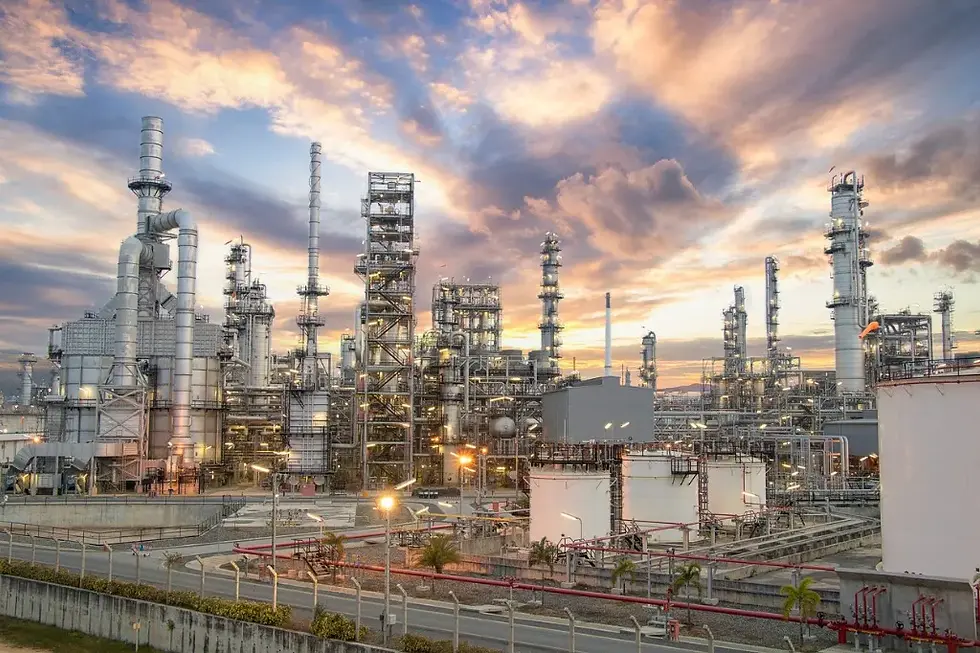Refining Refineries: How Small Tweaks Can Lead To Big Gains
- Asset Integrity
- Feb 26, 2024
- 3 min read
Updated: Feb 27, 2024

As the race to decarbonise the global economy gathers pace, and the 2050 target of achieving net zero looms, the role of oil refineries is increasingly under the spotlight. Being one of the larger industrial emitters of greenhouse gases, the hydrocarbon production and processing industry are prime target for ‘closure’ as pressure increases on countries to reduce their reliance on fossil fuels.
It is not as simple as that, however; refineries are an essential part of our lives as they produce many everyday things upon which we rely, beyond just transportation fuel: shampoo, packaging, lubricants and other products the world cannot easily do without are all made from refined products.

Aging refineries
So, while we transition away from fossil fuel use towards the increased production of renewable energy, how do we make sure that remaining refineries and equipment are maintained and used as efficiently and cleanly as possible?
With many refineries now getting relatively old – the average US refinery was built more than 40 years ago – there is a real opportunity to do more with what we have, rather than investing in and building new assets. It is all about getting more out of existing equipment, both in terms of performance as well as asset life. Refining margins can be razor thin, which also means that small changes can lead to big gains in terms of throughputs, margins, CapEx deferral and other KPIs such as Health, Safety, and Environmental performance. New advanced engineering simulation technology can play a key role in improving these critical metrics.
For example, it is now possible to optimise the start-up of heavy-wall reactor vessels by creating a near real-time structural digital twin of the asset. The insights that this brings to operators and engineers enables informed decision-making on where the start-up/shutdown process can be accelerated. For one of our customers, we are looking to decrease the start-up time by 6 to 12 hours. That may not seem like a lot, but let’s think about what that means on a global scale with over 600 refineries. If we were to replicate that accelerated start-up everywhere, we could avoid having to build an entire new refinery simply by getting more from existing equipment.
There is also a major upside when it comes to inspection and maintenance, as a structural twin can tell the inspection and maintenance team exactly, down to the nearest centimetre, where the safety critical areas are, and how much ‘life’ is left in them before requiring repair or replacement.

The opportunity is growing!
An additional opportunity is the refining world becoming more and more sensorized and robotized, which is creating an abundance of (unstructured) data. We hear increasingly from customers that they have state-of-the-art data acquisition. We also hear from them that they have significant challenges in translating this new data-abundance into actionable insights that operators can use to improve the company’s bottom line. Here, Akselos can help to combine data from processes, such as temperature and pressure, with data from manual/automated inspection in order to give customers new insights about the state of their asset. This can, for example, help to make informed decisions on how to operate a pressure vessel in order to safely make it to the next planned turnaround, versus running the risk of vessel failure and costly unplanned downtime prior to that turnaround. Those same insights can also be used to drive more informed maintenance and inspection decisions, helping to extend life of the asset.
Ultimately, the reality is that we do need hydrocarbon processing facilities and, in all probability, will continue to do so for some considerable time to come, even in the midst of an energy transition. The good news is that there is a lot more we can do with what we have. By improving their viability and efficiency, and by being innovative, we should seek to improve existing facilities, therefore freeing up time and capital, which will allow us to concentrate on the development of cleaner, more efficient technologies. Even better is that the technology required to achieve this already exists – all we have to do is use it.
Source: Akselos
